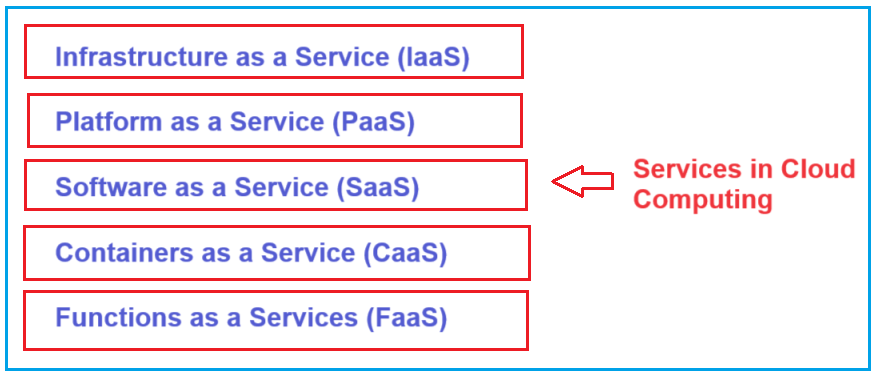Back to: Cloud Computing Tutorials for Beginners and Professionals
Infrastructure as a Service (IaaS) in Cloud Computing
In this article, I will discuss Different Types of Services in Cloud Computing. Please read our previous article discussing the differences between Public, Private, and Hybrid Clouds in Cloud Computing.
Different Types of Services in Cloud Computing
In cloud computing, services are typically categorized into five main types: Infrastructure as a Service (IaaS), Platform as a Service (PaaS), Software as a Service (SaaS), Containers as a Service (CaaS), and Functions as a Services (FaaS).

Infrastructure as a Service (IaaS):
This service model provides virtualized computing resources over the Internet. IaaS allows users to rent IT infrastructure such as servers, virtual machines, storage, networks, and operating systems from a cloud provider on a pay-as-you-go basis. This model offers maximum flexibility and control over IT resources and is widely used for migrating existing applications to the cloud.
Features:
- Virtual machines, storage, and networks
- High flexibility and scalability
- Pay-as-you-go pricing model
Examples:
- Amazon Web Services (AWS) EC2
- Microsoft Azure Virtual Machines
- Google Cloud Compute Engine
Platform as a Service (PaaS):
PaaS provides a platform allowing customers to develop, run, and manage applications without the complexity of building and maintaining the infrastructure typically associated with developing and launching an app. PaaS can streamline workflows when multiple developers are working on the same project. It simplifies the process of developing and deploying applications.
Features:
- Development frameworks and tools
- Middleware and database management
- Built-in scalability and load balancing
Examples:
- Google App Engine
- Microsoft Azure App Services
- AWS Elastic Beanstalk
Software as a Service (SaaS):
SaaS delivers software applications over the Internet on a subscription basis. The service provider hosts and maintains these applications, making them accessible from anywhere. It is the most widely recognized form of cloud service. SaaS providers manage the infrastructure, platforms, and software, and users connect to the service via a web browser.
Features:
- Accessible via web browsers
- Managed by the service provider
- Automatic updates and patches
Examples:
- Google Workspace (formerly G Suite)
- Microsoft Office 365
- Salesforce
Function as a Service (FaaS):
FaaS, also known as serverless computing, allows developers to execute code in response to events without managing the underlying infrastructure. It is a subset of PaaS. The cloud provider automatically handles the physical hardware, virtual machine operating systems, and web server software management.
Features:
- Event-driven execution
- Automatically scales with demand
- Pay only for the execution time
Examples:
- AWS Lambda
- Google Cloud Functions
- Azure Functions
Container as a Service (CaaS):
CaaS is a cloud service model that allows users to manage and deploy containers (standardized executable components combining application source code with the operating system (OS) libraries and dependencies required to run that code in any environment) using container-based virtualization. A CaaS provider will typically offer a container orchestration platform like Kubernetes.
Features:
- Automated deployment, scaling, and management of containers.
- Easily scale containerized applications to handle varying loads.
- Built-in security features for container isolation and access control.
- Seamless integration with CI/CD pipelines and development tools.
- Tools for monitoring container performance and logging activities.
- Containers can be easily moved across different environments.
Examples:
Google Kubernetes Engine (GKE)
Azure Kubernetes Service (AKS).
Amazon Elastic Kubernetes Service (EKS)
Additional Types of Services in Cloud Computing:
With cloud technologies advancing and maturing so fast, we now have the following two types of cloud computing services in addition to these five cloud offerings.
Storage as a Service (STaaS):
Storage as a Service (STaaS) is a data storage provisioning model in which a service provider rents space in their infrastructure to a customer. Customers can store data and files in the cloud, accessible via the Internet. STaaS offers scalability, which means customers can increase or decrease their storage capacity as needed and only pay for the storage they use. It eliminates the need for businesses to purchase and manage their own physical storage infrastructure. This can be beneficial for small to medium-sized enterprises that may not have the capital for large-scale storage hardware.
Key Features:
- Users can scale storage capacity up or down based on their needs without worrying about hardware limitations.
- Data is accessible from anywhere with an internet connection, making it suitable for remote teams and distributed applications.
- Users pay for the storage they use, similar to other cloud services.
Examples:
- Amazon Simple Storage Service (Amazon S3)
- Google Cloud Storage
- Azure Blob Storage
Database as a Service (DBaaS):
Database as a Service (DBaaS) allows users to access and use a cloud database system without setting up physical hardware, installing software, or configuring for performance. All administrative tasks and maintenance are handled by the cloud provider, which can dramatically reduce the complexity of database management. DBaaS enables businesses to manage data efficiently while dynamically scaling. This service model supports several database systems, such as relational, NoSQL, and NewSQL databases.
Key Features:
- Cloud providers handle database administration tasks such as backups, updates, and scaling, freeing users from these responsibilities.
- Users can easily scale their database resources up or down based on demand without downtime.
- Databases are accessible from anywhere, enabling global access for applications and users.
Examples:
- AWS RDS (Relational Database Service)
- Microsoft Azure SQL Database
- Google Cloud SQL
In the next article, I will discuss Infrastructure as a Service, also called IaaS, in detail. In this article, I explain the Different Types of Services in Cloud Computing. I hope you enjoy this Different Types of Services in Cloud Computing article.

